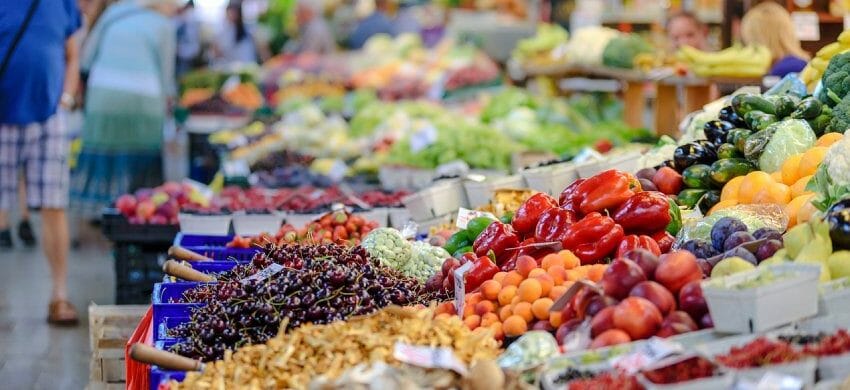Last Updated: March 22, 2024
Crafting a Perfect Budget?

Disclaimer: We are not qualified legal or tax professionals and are not giving advice. Always speak with a qualified professional before making any legal or financial decisions.
Crafting the perfect grocery budget can feel like navigating a maze with no clear exit. With food prices fluctuating and household needs constantly changing, especially in these challenging times, it's easy to find yourself overspending in the grocery aisles.
Whether you're a meticulous planner or a spontaneous shopper, we all have faced the sticker shock at the checkout. But what if there was a way to shop smarter, not harder?
In this guide, we'll explore practical strategies to create a grocery budget that not only fits your financial goals but also brings joy and variety to your meals. Say goodbye to the stress of overspending and hello to a healthier, happier pantry.
Don't want to read through? Speak to a debt specialist right now.
Why Are Food Prices Increasing?
- Increasing Oil Prices – most of our food is shipped long distances and that adds to the cost. Secondly, most modern farming equipment uses a lot of fuel, and oil by-products are turned into fertilizer. Just that cost alone increases the cost of growing grains by 20%. When oil prices are high, add 40% to the cost of growing wheat, soy, and corn. This caused food prices to spike in 2008, 2012, and 2017.
- Climate Change – the more extreme weather we are seeing with the changing climate is making food more expensive. Whether it is freezing weather in Florida, droughts, and fires across the West Coast, extreme heat, or floods, these extremes either destroy crops and livestock or make growing more expensive and difficult. This caused food prices to start spiking back in 2011.
- Increased Meat Consumption – meat has long been a commodity that signifies wealth. Meat consumption is increasing worldwide and with it comes the increased need for pasturage, (and rainforest destruction) and supplement feeds like corn. This not only increases prices for both meat and grain but climate change as well.
- US Government Subsidies – these payments to farmers and ranchers keep prices artificially high so that the farmers and ranchers can purchase oil and oil byproducts and recover from climate change-caused catastrophes. In addition, much of US-grown corn is turned into ethanol. Ethanol is far better for the environment but it means corn is more expensive.
- World Trade Organization Stockpiling Limits – to even out trade from agriculturally subsidized countries like the US and the EU and unsubsidized countries, the WTO limits global stockpiling. While this helps farmers in unsubsidized counties to trade on even footing, it reduces the amount of food available and causes price volatility.
We can’t do much about the last two, but there are ways to limit your budget’s pinch by considering the other three.
Big Changes First
- Shop locally – If you can, focus on purchasing items that are grown or produced nearer to home. It is not always easy, especially if you live far from sites that produce food. Look for bakeries, butchers, and CSA (community-supported agriculture) options where you buy shares in produce. Farmer’s markets are good options as well.
- Shop in bulk
– if you find a good deal on something you will eat in or use in the future, buy a reasonable amount and store it. Keep in mind food in cans and boxes can and will go bad over time, so plan to use up your stockpile.
- Grow a garden – gardens don’t have to be a lot of work. You can grow a carefully selected series of veggies in your window. Try growing vegetables like lettuce, peppers, onions, scallions, and some herbs. Tomatoes are a possibility too, but they tend to harbor fungus flies (large fruit flies). There are also community gardens where you can share in the labor and the produce.
- Decrease your meat consumption – believe it or not, meat-free meals are not awful and bland tasting. Either you have never been exposed to the wonders of vegetarian food or you are rather set in your ways. You can begin by cutting meat out of one meal a day and then progress to a meatless day. Your grandparents most likely did it during WWII! Tofu and quinoa are excellent protein replacements. Both take on the flavor of what they are cooked with and can be used to stretch your meat supply. Quinoa is one of the healthiest foods available!
Small Changes Next
- Processed food – frozen meals and anything in a box is going to be more expensive and less healthy than what you make for yourself. Making wise choices when grocery shopping and buying good quality food is better than boxed meals. Plus you can make leftovers.
- Leftovers – plan for leftovers by making a bit more than you normally would. Freeze your leftovers and have those instead of eating out. Restaurant food has a lot of costs built into it and you can create meals far more cheaply than you can buying them prepared.
- Eat out less – Americans spend about 9% of their income on food and 5% goes to eating out. By making meals at home, brown-bagging it, and making your own coffee, you can save a lot of money over time. Save eating out for once in a while.
- Leave your credit card at home – avoid making up food budget shortfalls with your credit card. Instead cut out the frills and fluff in your grocery purchases. Keep things simple.
- Shop competitively – without driving all over town and increasing your gas consumption, look for sales at different grocery stores. Shop off the sale flyers and coupons and consider using store loyalty cards.
- Check out grocery apps – there are several grocery apps available to help you shop competitively. You do give up some privacy, but you can also save money.
- Create a meal plan
– planning can help you to shop wisely. Plan first using sales flyers, then shop your plan.
Meal By Meal
- Breakfast
– eggs, bacon, and grains are the traditional breakfast. Instead, try oatmeal which is cheap and is very healthy. Breakfast cereal runs the gamut from an expensive vehicle for sugar to very healthy. The price of breakfast cereal has gone up less than eggs, so that makes it a better choice.
- Lunch
– since the price of carbonated beverages has shot up, avoid those to save some money. Peanut butter is called the poor man’s protein by bicycle racers, so a good PBJ is a nice replacement for meat. Potatoes are also a filling lunch and very inexpensive to buy.
- Dinner
– meat prices have increased steadily – from 3% to 5.8% – far more than vegetable prices. The less meat you eat, the healthier you are, and the less you have to spend on food. Look for meat-free or reduced meat recipes – there are excellent websites like budgetbytes that will help you save money on creating meals. Tough, cheaper cuts of meat do well when slow-cooked into stews.
Grocery Budget Tips
- Shop according to a plan.
- Buy good deals in moderation.
- Shop locally for better quality.
- Create leftovers instead of eating out.
Determine Your Grocery Budget
Before creating your grocery budget, you need to know how much you can realistically afford. Take into account your monthly take-home income and subtract any fixed expenses like housing, transportation, insurance, etc. The remainder is what you have left for variable expenses including groceries. For help determining exact budget numbers tailored to your financial situation.
Once you know your grocery budget amount, download a free grocery budget template to track your spending. This worksheet includes columns for budgeted amount, actual amount, and difference to easily see if you go over or under budget each month.
Make a Grocery List
One of the best ways to stick to your new grocery budget is to plan meals and make a list before shopping. Include ingredients for breakfast, lunch, dinner, and snacks. Refer to weekly grocery store flyers to find the best deals and plan recipes around what's on sale.
Additional Budgeting Resources
For more money management tips and printable worksheets, explore our financial literacy resources. This covers topics like creating a budget, cutting expenses, managing debt, and more.
FAQs
Conclusion
Creating and sticking to a monthly grocery budget takes some effort but pays off tremendously in the long run. Now that you know how much you should be spending on groceries, you can meal plan intelligently and shop with purpose. Use our grocery log template to track spending and visualize your progress.
If you need additional support getting out of debt, contact Pacific Debt today. Our financial experts can provide customized debt management or debt settlement services to help you consolidate payments and pay off balances faster. The journey to financial freedom starts with a phone call. Reach out now to schedule your free debt consultation.
Pacific Debt, Inc
If your finances have spiraled out of control and debt has taken over your life, Pacific Debt, Inc. may be able to help. If you have any questions, contact one of our debt specialists today. We offer a free consultation and we can help explain your options to you.
*Disclaimer: Pacific Debt Relief explicitly states that it is not a credit repair organization, and its program does not aim to improve individuals' credit scores. The information provided here is intended solely for educational purposes, aiding consumers in making informed decisions regarding credit and debt matters. The content does not constitute legal or financial advice. Pacific Debt Relief strongly advises individuals to seek the counsel of qualified professionals before undertaking any legal or financial actions.
✔ Accredited by Better Business Bureau with BBB A+ rating (4.93 rating and 1678 reviews)
✔ US News and World Reports and Bankrate ranked Pacific Debt Relief as one of “The Best Debt Relief Companies of 2024”
✔ 6.9 star rating by BestCompany.com (over 2379 client reviews)
✔ 4.8 star rating by TrustPilot based (over 1613 verified consumer reviews)
✔ ConsumerAffairs.com Accredited (over 544 verified reviews with an average rating of 5 stars)
✔ A Top 10 Rated Compan by TopTenReviews.com , ConsumersAdvocate.com and Top10debtconsolidation.com
✔ 4.6 star rating by Google (229 client reviews)
✔ 100% rating by SuperMoney (9 client reviews)
Reduce Your Credit Card Debt By Up to Half

BBB Reviews | 4.9/5.0 Rating









 Do Not Sell My Personal Information
Do Not Sell My Personal Information